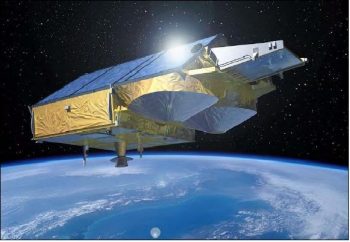
CryoSat. Credit: ESA/P. Carril
On Monday 9 July, 2018, engineers based at the European Space Operations Centre (ESOC) in Germany made the decision to alter the path of the CryoSat satellite, preventing a potentially fatal collision between it and an ‘unknown object’. For the second time this year the risk of collision was deemed high enough to give the satellite instructions to get out of the way.
CryoSat is ESA’s mission dedicated to measuring the thickness of polar sea ice and monitoring changes in the ice sheets blanketing Greenland and Antarctica. Flying at an altitude of just over 700 km and travelling from pole to pole, Cryosat keeps us informed about an often cited ‘early casualty’ of global warming, Earth’s ice.
The first warning of trouble came about a week before the event from the Joint Space Operations Center (JSpOC) in the US, informing ESA’s Space Debris Office that a potential collision was on the horizon.
Time of close approach: Monday 9 July, 04:24 UTC.

3D collision plot. Credit: Spacecraft Conjunction Assessment and Risk Front-end (SCARF)
“We received the first CDM (Conjunction Data Message) from JSpOC on 2 July 2018 at 08:02 UTC. At this point the chance of collision was still below our threshold of 1 in 10 000. By 5 July 2018, 23:00 UTC, the probability had climbed above the threshold and we informed the mission the next morning.” describes Vitali Braun, Space Debris Engineer at ESA’s Space Debris Office.
“It is a somewhat different feeling than usual work, but there’s only a small amount of stress or concern. The teams involved know exactly what to do and everyone is very professional.”

CryoSat operations team waiting for updates from the satellite at the Earth Observation Control Room at ESOC
So the warning was passed from the Space Debris office to the team operating CryoSat at the Earth Observation Mission Control Room.
Giuseppe Albini, CryoSat Spacecraft Operations Engineer recounts: “The object was approaching from behind and below CryoSat, and even though its orbit is monitored and tracked, its origin is unknown. We had one lunchtime meeting with the Space Debris Office, Flight Dynamics, the Flight Control Team and the Mission Manager, Tommaso Parrinello. Considering the collision probability exceeded 1/10000, we decided to prepare the manoeuvre, and as this was happening over the weekend, cancel our plans!”
Getting CryoSat to safety
On Sunday the commands were sent to CryoSat, on Monday, 50 minutes before the potential collision, its thrusters fired, and because of the swift action of many experienced and dedicated teams the chance of collision dropped from 1 in 10 000 to 1 in 1 000 000.
By firing its thrusters CryoSat increased its speed, and in so doing increased its ‘orbital energy’, pushing it into a higher orbit around the Earth. Instead of a distance of 14-metres between the two objects at their closest point, CryoSat passed more than 120-metres above the unknown object, or ‘chaser’.
Chasers might be operational satellites, dead satellites, spent rocket parts, mission-related debris e.g. lens covers, payload adapters, and the most common source, explosion and collision fragments.
Back to work

CryoSat. Credit: ESA/AOES
After it was confirmed that CryoSat had successfully avoided collision, the operations team began preparations to get it back into an orbit that would allow it to continue its vital work.
“The collision avoidance manoeuvre performed early on Monday raised the orbit of CryoSat outside the optimal altitude. We are currently preparing the commands that will implement a second manoeuvre, ensuring CryoSat is able to satisfy its scientific mission in the weeks to come,” explained Elia Maestroni, CryoSat-2 Spacecraft Operations Manager.
With these commands CryoSat again fired its thrusters, but this time in the opposite direction, slowing it down by 3.043 cm/s and so lowering its orbit.
By Thursday, CryoSat was back at work.
The problem of junk

Artist’s impression of space debris around Earth. Credit: ESA/ID&Sense/ONiRiXEL, CC BY-SA 3.0 IGO
None of this would have been possible without the dedication and experience of the teams involved, but an event like this still comes at some cost. Every time CryoSat fires its thrusters it uses some of its fuel, ultimately shortening the length of its mission.
This is CryoSat’s second Collision Avoidance Manoeuvre of 2018 and the 14th since it launched in 2000, and according to Vitali Braun, events like this are becoming more common:
“about 50% of all alerts and Collision Avoidance Manoeuvres at ESOC are due to fragments left over from two particular events: the anti-satellite test conducted by the Chinese military in 2007, which destroyed the former weather satellite Fengyun-1C and left a huge debris cloud behind, and the collision of two intact spacecraft, Iridium-33 and Cosmos-2251, in 2009. One could say that we have doubled the amount of chaser objects since 2007 and thus also the frequency of manoeuvres like this. This only applies however to our satellites in Low Earth Orbit, like the Sentinels, CryoSat and Swarm.”
For more information on the problem of debris, check out ESA’s 2017 report on space junk.

Space debris GIF. Credit: ESA, CC BY-SA 3.0 IGO
from Rocket Science https://ift.tt/2urGl1l
v

CryoSat. Credit: ESA/P. Carril
On Monday 9 July, 2018, engineers based at the European Space Operations Centre (ESOC) in Germany made the decision to alter the path of the CryoSat satellite, preventing a potentially fatal collision between it and an ‘unknown object’. For the second time this year the risk of collision was deemed high enough to give the satellite instructions to get out of the way.
CryoSat is ESA’s mission dedicated to measuring the thickness of polar sea ice and monitoring changes in the ice sheets blanketing Greenland and Antarctica. Flying at an altitude of just over 700 km and travelling from pole to pole, Cryosat keeps us informed about an often cited ‘early casualty’ of global warming, Earth’s ice.
The first warning of trouble came about a week before the event from the Joint Space Operations Center (JSpOC) in the US, informing ESA’s Space Debris Office that a potential collision was on the horizon.
Time of close approach: Monday 9 July, 04:24 UTC.

3D collision plot. Credit: Spacecraft Conjunction Assessment and Risk Front-end (SCARF)
“We received the first CDM (Conjunction Data Message) from JSpOC on 2 July 2018 at 08:02 UTC. At this point the chance of collision was still below our threshold of 1 in 10 000. By 5 July 2018, 23:00 UTC, the probability had climbed above the threshold and we informed the mission the next morning.” describes Vitali Braun, Space Debris Engineer at ESA’s Space Debris Office.
“It is a somewhat different feeling than usual work, but there’s only a small amount of stress or concern. The teams involved know exactly what to do and everyone is very professional.”

CryoSat operations team waiting for updates from the satellite at the Earth Observation Control Room at ESOC
So the warning was passed from the Space Debris office to the team operating CryoSat at the Earth Observation Mission Control Room.
Giuseppe Albini, CryoSat Spacecraft Operations Engineer recounts: “The object was approaching from behind and below CryoSat, and even though its orbit is monitored and tracked, its origin is unknown. We had one lunchtime meeting with the Space Debris Office, Flight Dynamics, the Flight Control Team and the Mission Manager, Tommaso Parrinello. Considering the collision probability exceeded 1/10000, we decided to prepare the manoeuvre, and as this was happening over the weekend, cancel our plans!”
Getting CryoSat to safety
On Sunday the commands were sent to CryoSat, on Monday, 50 minutes before the potential collision, its thrusters fired, and because of the swift action of many experienced and dedicated teams the chance of collision dropped from 1 in 10 000 to 1 in 1 000 000.
By firing its thrusters CryoSat increased its speed, and in so doing increased its ‘orbital energy’, pushing it into a higher orbit around the Earth. Instead of a distance of 14-metres between the two objects at their closest point, CryoSat passed more than 120-metres above the unknown object, or ‘chaser’.
Chasers might be operational satellites, dead satellites, spent rocket parts, mission-related debris e.g. lens covers, payload adapters, and the most common source, explosion and collision fragments.
Back to work

CryoSat. Credit: ESA/AOES
After it was confirmed that CryoSat had successfully avoided collision, the operations team began preparations to get it back into an orbit that would allow it to continue its vital work.
“The collision avoidance manoeuvre performed early on Monday raised the orbit of CryoSat outside the optimal altitude. We are currently preparing the commands that will implement a second manoeuvre, ensuring CryoSat is able to satisfy its scientific mission in the weeks to come,” explained Elia Maestroni, CryoSat-2 Spacecraft Operations Manager.
With these commands CryoSat again fired its thrusters, but this time in the opposite direction, slowing it down by 3.043 cm/s and so lowering its orbit.
By Thursday, CryoSat was back at work.
The problem of junk

Artist’s impression of space debris around Earth. Credit: ESA/ID&Sense/ONiRiXEL, CC BY-SA 3.0 IGO
None of this would have been possible without the dedication and experience of the teams involved, but an event like this still comes at some cost. Every time CryoSat fires its thrusters it uses some of its fuel, ultimately shortening the length of its mission.
This is CryoSat’s second Collision Avoidance Manoeuvre of 2018 and the 14th since it launched in 2000, and according to Vitali Braun, events like this are becoming more common:
“about 50% of all alerts and Collision Avoidance Manoeuvres at ESOC are due to fragments left over from two particular events: the anti-satellite test conducted by the Chinese military in 2007, which destroyed the former weather satellite Fengyun-1C and left a huge debris cloud behind, and the collision of two intact spacecraft, Iridium-33 and Cosmos-2251, in 2009. One could say that we have doubled the amount of chaser objects since 2007 and thus also the frequency of manoeuvres like this. This only applies however to our satellites in Low Earth Orbit, like the Sentinels, CryoSat and Swarm.”
For more information on the problem of debris, check out ESA’s 2017 report on space junk.

Space debris GIF. Credit: ESA, CC BY-SA 3.0 IGO
from Rocket Science https://ift.tt/2urGl1l
v

Aucun commentaire:
Enregistrer un commentaire